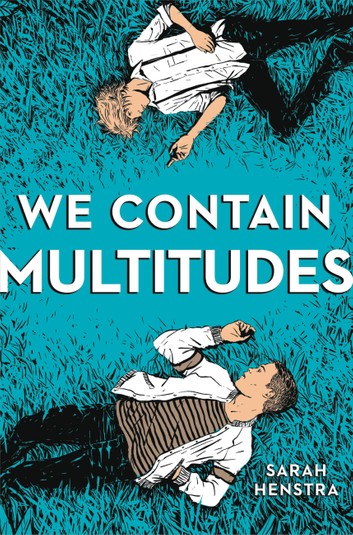
We Contain Multitudes
کتاب های مرتبط
- اطلاعات
- نقد و بررسی
- دیدگاه کاربران
نقد و بررسی

Starred review from March 1, 2019
An archaic form of communication, a contemporary setting, and the timeless lure of love.Jo and Kurl attend the same Minnesota school and are pen pals by class assignment. A bow-tied gay dandy and brawny football star respectively, polar opposition on the high school spectrum makes their pairing and correspondence even more poignant. Jo's letters underscore his affinity for Walt Whitman and the reality of incessant bullying. Brooding, beefy Kurl scolds Jo for making himself a target (yet still fends off the bullies like a devoted, disgruntled bodyguard), evolves as a thoughtful writer, and reveals the root of his volatile temper. Over the course of a year, an affection between the two develops, as does a romance with all the trappings of secrecy, revelation, separation, sobs, sex, and longing. The dual narrative differs from other storytelling duets in that these points of view aren't separate; the written perceptions of one character are scrutinized and shared through the lens of the other. A love story, a therapy session, a reason to read Whitman--the sweetness of unexpected amour is here, as is the saline of sadness. The main characters are white; diversity in secondary characters is implied through names. Graphic toxic masculinity, familial abuse, drug use, and sexual betrayal are balanced (not obliterated) by the beauty of love between two boys who never expected the best from each other.Your reason to root for love--and the power of the pen. (Fiction. 14-adult)
COPYRIGHT(2019) Kirkus Reviews, ALL RIGHTS RESERVED.

May 1, 2019
Gr 9 Up-Henstra's follow-up to Mad Miss Mimic will give romantic and cerebral teens good reason to suspend disbelief. High school sophomore Jonathan and senior Adam are assigned to be correspondents by their English teacher, and it is the ensuing flood of letters that form both the novel and readers' perspective on their evolving relationship. Jonathan is an openly gay kid who models his wardrobe and his language after his literary hero Walt Whitman, while Adam is a private former football star reputed to take no prisoners in fistfights. As their exchange of thoughts and questions develops, however, the two boys discover how much they have in common and how fully the other one brings him into a more complete life and way to consider personal and public options for action. While the extent of the epistolary conceit might beg credulity, plenty of other details here are realistic: the two boys' different but equally troubled families, the important roles siblings play in forming and maintaining one's own identity, and the difficulties inherent in hammering out a healthy, loving relationship among these. VERDICT Teen readers can take heart from Jonathan and Adam's story, especially if they care about Walt Whitman as a gay icon.-Francisca Goldsmith, Library Ronin, Worcester, MA
Copyright 2019 School Library Journal, LLC Used with permission.

June 10, 2019
Henstra’s return to YA (Mad Miss Mimic) tackles gay contemporary teen life via epistolary format. High school student Jonathan “Little Jo” Hopkirk is a gay, bow tie–wearing Walt Whitman fan. Adam Kurlansky (Kurl) is a reserved former football star who quit the team suddenly under strange circumstances. Assigned to one another as part of a weekly pen pal exchange at their high school—and despite their vastly differing interests—they develop a rapport via classroom mail that builds into frequent correspondence and, eventually, romance. Jo’s formally styled writing, studded with Whitman quotations, touches on life’s passions and on being bullied at school, and Kurl’s more casual missives discuss his family: his brother’s return from Afghanistan and his mercurial, controlling uncle. The correspondence at times stretches believability by recounting events and conversations for which both characters were present (“You were there, after all. You don’t need me to reconstruct the scene for you”). But as a medium for reporting day-to-day occurrences and conveying intimate feelings and classic themes—love, lust, and betrayal, among others—the letters shine. While the story’s format and build may strain credulity for some, the volume is likely to find admirers among fans of teen romance. Ages 14–up.

Starred review from March 1, 2019
Grades 9-12 *Starred Review* Where to begin? This novel's conceit is that it consists entirely of letters exchanged by two boys as part of a sophomore English class project. Adam Kurlansky and Jonathan Hopkirk (or Kurl and Little Jo, as they address each other) make an unlikely couple. Kurl is taciturn, expressionless, and an erstwhile football player who has quit the team under mysterious circumstances. Little Jo is a short, slender, openly gay boy, who idolizes the poet Walt Whitman, whose words become a leitmotif of this remarkable novel. Both boys are gifted writers, and their letters grow increasingly artful as they get to know each other on and off the page?and subsequently fall in love. However, this is not the denouement but rather the beginning of a closely examined relationship that, as the two unusually introspective boys describe it in their letters, becomes almost philosophical. This is an absolutely extraordinary work of fiction that illustrates how artful epistolary novels can be. Kurl and Jo are characters to die for, emotionally compelling and empathetic. Their quotidian lives are riveting and their story unforgettable. At one point, Jo describes a novel he's reading by saying, I can't even summarize the plot; it's that strange and sad and marvelous a story. There's no better way to describe Henstra's own novel. It is not to be missed.(Reprinted with permission of Booklist, copyright 2019, American Library Association.)

























دیدگاه کاربران